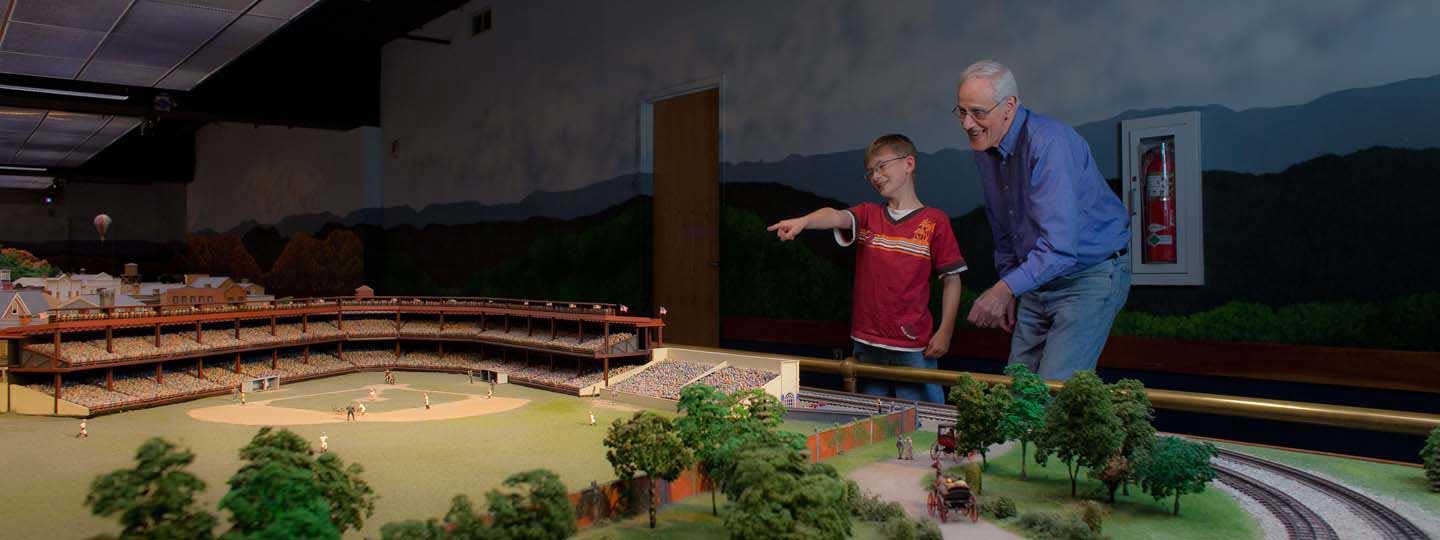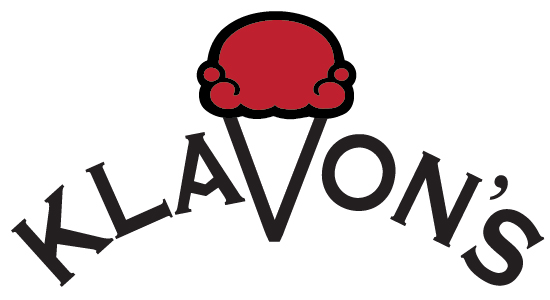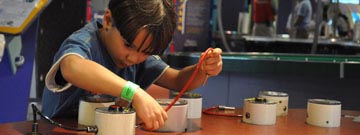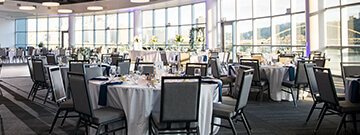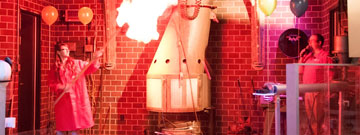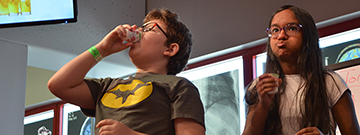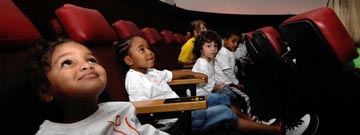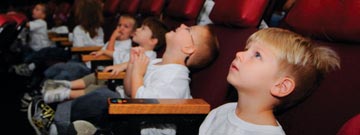FAQs
How do the boats work?
Our boats are controlled with magnets. Magnets located on the bottom of each boat correspond to opposing magnets mounted on a geared chain and sprocket system mounted under the river. Magnetic attraction pulls the boats through the water.
Is that real water?
Yes! Our river is approximately 3 inches deep.
How big is the Miniature Railroad & Village®?
The platform is 83 feet long by 30 feet wide.
How many trains are there?
This figure varies, because more than one locomotive can run on each track. Generally, five trains and one trolley operate at one time.
How old is the Miniature Railroad & Village®?
The Miniature Railroad & Village® was first displayed on Christmas Eve, 1919.
How much did it cost to build?
More than you have! Remember the stimulus plan? Really, it is impossible to put a monetary cost to the Miniature Railroad & Village®. The countless hours our staff and volunteers contribute to maintaining the exhibit and creating new models, building trees, harvesting the wild hydrangea, the materials make the beloved exhibit priceless to hundreds of thousands.
What are the trees made of?
The deciduous model trees and most of the bushes are made from a wildflower called wild hydrangea that we harvest each autumn. For the exhibit each year, we collect hundreds of thousands of flower tops from dried hydrangea plants. The hydrangea plant grows on rocky banks and moist wooded ravines, particularly along the steeper slopes of creek beds.
Each tree is painstakingly handmade by twisting a copper wire to shape the tree’s main trunk and then the limbs. Remember, no two trees are alike. Our artists try hard to make each model tree slightly different. When a flower top is completely dried, it is ready to be placed in pieces onto the bare tree with hot glue. The tree is painted green, orange, or even ocher, depending on the season. Finally, the trunk and branches are carefully coated with a layer of hot beeswax to simulate bark. A single tree can take hours or even an entire day to make! Hundreds of thousands appear on the display.
What scale is the exhibit?
We follow the “O” Scale, where 1/4 inch equals 1 foot.
How are the historical replicas constructed?
After a particular historic structure is chosen, our staff members begin their research, seeking out as much historical documentation as possible, including blueprints if available. Detailed measurements and many photographs are taken for study and reference in the creation of scale architectural drawings. Because most of our replicas are unique, it is rare that we find ready-made construction materials. Imagination is key. One of the most unusual building materials ever used was angel hair pasta, which was used to replicate a fine ivy design on the front porch of a Liverpool St. row house. Each model is carefully constructed to duplicate the original in all ways. When you visit, many of our staff members and volunteers can point out these unusual materials on the display.
How do the animated features work?
Many simple machines are at work under the display to control the animations. Each of the nearly 100 animations on the exhibit is independently controlled by its own motor and an arrangement of gears or cams connected to a small wire drive shaft. This mechanism directs the desired movement. Great care is taken to hide the mechanics so that the magic of the illusion is maintained.
What is the best way to view the Miniature Railroad & Village®?
The best way to view the railroad display is slowly... and from a low perspective. Children who are the same height as the display enjoy the most magical view of all. The exhibit staff members are careful to put in place things that can only be enjoyed from such a child’s view.
Why do we only have Lionel trains?
We are maintaining a relationship established years ago at the Buhl Planetarium. Since before 1954, Lionel has donated all the trains we operate. Additionally, during the last decade at Carnegie Science Center, the relationship has expanded to include a product line and an annual Miniature Railroad & Village® boxcar.
Can I volunteer at the Miniature Railroad & Village®?
Sure can! The Miniature Railroad & Village® volunteer team is a crucial part of our operations. If you would like to become a volunteer, please contact Carnegie Science Center’s Volunteer Office.
Where did the Miniature Railroad & Village® originate?
Brookville, Pa. was the first home of the display that later became the Miniature Railroad & Village®. Read about the exhibit’s history.
Is the Miniature Railroad & Village® the same display that was at the Buhl Planetarium?
Yes, though it was completely redesigned and enlarged 60 percent at Carnegie Science Center when it moved in 1992.
How long is the Miniature Railroad & Village® open each year?
The display is open nearly year round, closing only for a maintenance period each fall beginning at the end of September and running through the day after Thanksgiving. On Black Friday, each year’s new model is debuted.
Who was Charles Bowdish?
Charles Bowdish was a disabled veteran of World War I who started a small display complete with trains and model buildings of downtown Brookville in honor of his brother’s wedding on Christmas Eve, 1920. News about his miniature display spread, and so Charles opened his home for the public to enjoy his creation. It became a huge holiday tradition in Brookville until December 1954, when it was relocated it to the Buhl Planetarium and became the Miniature Railroad & Village®. The Buhl Planetarium became Carnegie Science Center when it opened its doors in 1991, and the display made its official move to its home at the Science Center in 1992.


